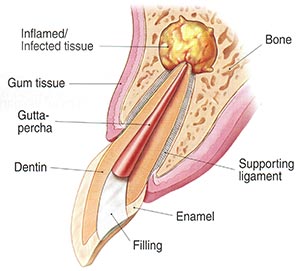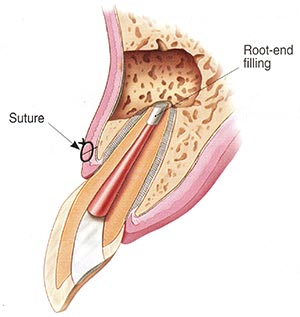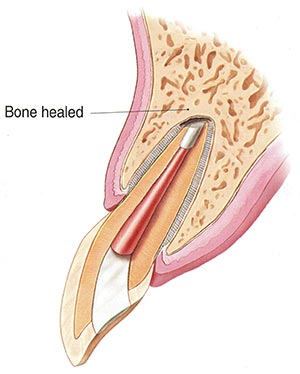Why would I need endodontic surgery?
Surgery can help save your tooth in a variety of situations.
- Surgery may be used in diagnosis. If you have persistent symptoms but no problems appear on your x-ray, your tooth may have a tiny fracture or canal that could not be detected during nonsurgical treatment. In such a case, surgery allows Dr. Shoushtari to examine the root of your tooth, find the problem and provide treatment.
- Sometimes calcium deposits make a canal too narrow for the cleaning and shaping instruments used in nonsurgical root canal treatment to reach the end of the root. If your tooth has this “calcification,” Dr. Shoushtari may perform endodontic surgery to clean and seal the remainder of the canal.
- Usually, a tooth that has undergone a root canal can last for many years. However, in a few cases, a tooth may fail to heal. The tooth may become painful or diseased months or even years after successful treatment. If this is true for you, surgery may help save your tooth.
- Surgery may also be performed to treat damaged root surfaces or surrounding bone.
 Although there are many surgical procedures that can be performed to save a tooth, the most common is called apicoectomy or root-end resection. When inflammation or infection persists in the bony area around the end of your tooth after a root canal procedure, Dr. Shoushtari may have to perform an apicoectomy. Of course, there are no guarantees with any surgical procedure.
Although there are many surgical procedures that can be performed to save a tooth, the most common is called apicoectomy or root-end resection. When inflammation or infection persists in the bony area around the end of your tooth after a root canal procedure, Dr. Shoushtari may have to perform an apicoectomy. Of course, there are no guarantees with any surgical procedure.
What is an apicoectomy?
In this procedure, Dr. Shoushtari opens the gum tissue near the tooth to see the underlying bone and to remove any inflamed or infected tissue. The very end of the root is also removed.

A small filling may be placed to seal the end of the root canal and a few stitches or sutures are placed in the gum to help the tissue heal properly.

Over a period of months, the bone heals around the end of the root.

Are there other types of endodontic surgery?
Other surgeries Dr. Shoushtari might perform include dividing a tooth in half, repairing an injured root or even removing one or more roots. Dr. Shoushtari will be happy to discuss the specific type or surgery your tooth requires.
In certain cases, a procedure called intentional replantation may be performed. In this procedure, a tooth is extracted, treated with an endodontic procedure while it is out of the mouth and then replaced in its socket.
These procedures are designed to help you save your tooth.
Will the procedure hurt?
Local anesthetics make the procedure comfortable. Of course, you may feel some discomfort or experience swelling while the incision heals. This is normal for any surgical procedure. Dr. Shoushtari will recommend appropriate pain medication to alleviate your discomfort.
We will give your specific postoperative instructions to follow. If you have questions after your procedure, or if you have pain that does not respond to medication, call our office.
What are the alternatives to endodontic surgery?
Often, the only alternative to surgery is extraction of the tooth. The extracted tooth must be replaced with an implant, bridge or removable partial denture to restore chewing function and to prevent adjacent teeth from shifting.
No matter how effective modern tooth replacements are-and they can be very effective-nothing is as good as a natural tooth. You have already made an investment in saving your tooth. The pay-off for choosing endodontic surgery could be a healthy, functioning, natural tooth for the rest of your life.